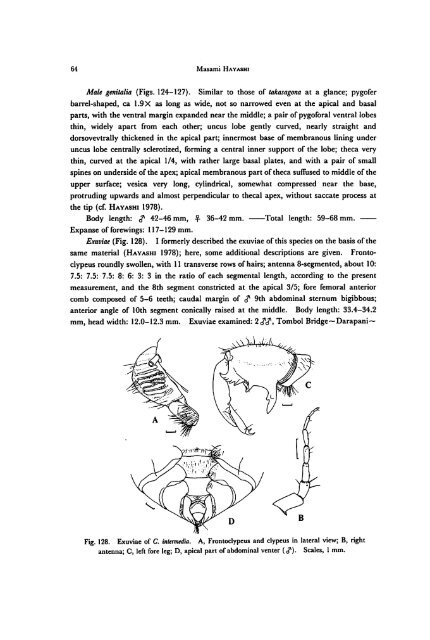A Revision of the Genus Cryptotympana (Homoptera, Cicadidae)
A Revision of the Genus Cryptotympana (Homoptera, Cicadidae)
A Revision of the Genus Cryptotympana (Homoptera, Cicadidae)
You also want an ePaper? Increase the reach of your titles
YUMPU automatically turns print PDFs into web optimized ePapers that Google loves.
64 Masami HayashiMale genitalia (Figs. 124-127).Similar to those <strong>of</strong> takasagona at a glance; pyg<strong>of</strong>erbarrel-shaped, ca 1.9 X as long as wide, not so narrowed even at <strong>the</strong> apical and basalparts, with <strong>the</strong> ventral margin expanded near <strong>the</strong> middle; a pair <strong>of</strong> pyg<strong>of</strong>oral ventral lobesthin, widely apart from each o<strong>the</strong>r; uncus lobe gently curved, nearly straight anddorsovevtrally thickened in <strong>the</strong> apical part; innermost base <strong>of</strong> membranous lining underuncus lobe centrally sclerotized, forming a central inner support <strong>of</strong> <strong>the</strong> lobe; <strong>the</strong>ca verythin, curved at <strong>the</strong> apical 1/4, with ra<strong>the</strong>r large basal plates, and with a pair <strong>of</strong> smallspines on underside <strong>of</strong> <strong>the</strong> apex; apical membranous part <strong>of</strong><strong>the</strong>ca suffused to middle <strong>of</strong><strong>the</strong>upper surface; vesica very long, cylindrical, somewhat compressed near <strong>the</strong> base,protruding upwards and almost perpendicular to <strong>the</strong>cal apex, without saccate process at<strong>the</strong> tip (cf. Hayashi 1978).Body length: f 42-46 mm, 4 36-42 mm. Total length: 59-68 mm.Expanse <strong>of</strong> forewings: 117-129 mm.Exuviae (Fig. 128). I formerly described <strong>the</strong> exuviae <strong>of</strong>this species on <strong>the</strong> basis <strong>of</strong><strong>the</strong>same material (Hayashi 1978); here, some additional descriptions are given. Frontoclypeus roundly swollen, with 11 transverse rows <strong>of</strong> hairs;antenna 8-segmented, about 10:7.5: 7.5: 7.5: 8: 6: 3: 3 in <strong>the</strong> ratio <strong>of</strong> each segmental length, according to <strong>the</strong> presentmeasurement, and <strong>the</strong> 8th segment constricted at <strong>the</strong> apical 3/5; fore femoral anteriorcomb composed <strong>of</strong> 5-6 teeth; caudal margin <strong>of</strong> f 9th abdominal sternum bigibbous;anterior angle <strong>of</strong> 10th segment conically raised at <strong>the</strong> middle. Body length: 33.4-34.2mm, head width: 12.0-12.3 mm. Exuviae examined: 2ff, Tombol Bridge~Darapani~Fig. 128. Exuviae <strong>of</strong> C. intermedia. A, Frontoclypeus and clypeus in lateral view; B, rightantenna; C, left fore leg; D, apical part<strong>of</strong> abdominal venter(f). Scales, 1mm.
















